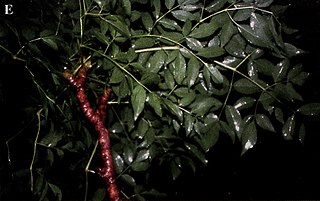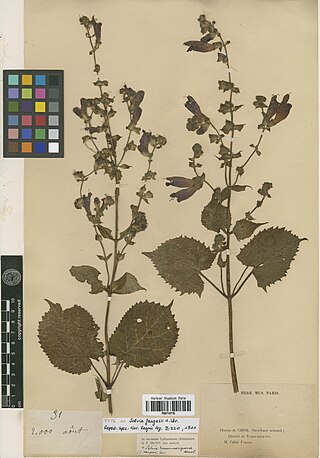Guayabillo is the common name for a number of species of plant. It may refer to:

Aralia excelsa is a species of flowering plant in the family Araliaceae. It is native to Mexico, Central America, northern South America and parts of the Caribbean.
Quararibea pterocalyx, the wild palm or cinco dedos, is a species of flowering plant in the family Malvaceae. It is found in Colombia, Costa Rica, Panama, and Venezuela. It is threatened by habitat loss.
Scalesia retroflexa is a species of flowering plant in the family Asteraceae. It is found only in the Galápagos Islands of Ecuador. It is threatened by habitat loss.

Asarum maximum is a species of plant in the family Aristolochiaceae. It is endemic to China. The flowers have a distinct smell of mushrooms.
Excoecaria benthamiana is a species of flowering plant in the family Euphorbiaceae. It is endemic to Seychelles.
Polyscias crassa is a species of plant in the family Araliaceae. It is endemic to Seychelles. It is threatened by habitat loss.

Ginoria is a genus of plants in the family Lythraceae. It contains 13 species which are native to southern Mexico and the Caribbean.
Oreopanax sanderianus is a species of plant in the family Araliaceae. It is found in Guatemala, Honduras, and Mexico. It is threatened by habitat loss.
Phoebe bournei is a species of tree up to 20 metres (66 ft) tall in the family Lauraceae. It is endemic to China, where it occurs in Fujian, Guangdong, Guangxi, Guizhou, Hainan, Hubei, and Jiangxi provinces. It is threatened by habitat loss. The species is under second-class national protection in China.
Saurauia oreophila is a species of flowering plant in the family Actinidiaceae. It is found in Guatemala and Mexico. It is threatened by habitat loss.
Saurauia scabrida is a species of flowering plant in the family Actinidiaceae. It is endemic to Mexico.

Dalbergia retusa is a plant species in the familyFabaceae . It is found in Pacific regions of Central America, ranging from Panama to southwestern Mexico. It produces the cocobolo wood. It is a fair-sized tree, reported to reach 20–25 m in height. This is probably the species contributing most of the wood in the trade. Because of the wood's great beauty and high value, the trees yielding this wood have been heavily exploited and are now rare outside national parks, reserves, and plantations.

Salvia maximowicziana is a perennial plant in the family Lamiaceae. It is found growing on grasslands, forests, and forest edges in China, at 1,800 to 3,300 m elevation. It grows 10 to 90 cm tall, with circular-cordate to ovate-cordate leaves that are typically 3 to 8 cm long and 6 to 8 cm wide. The upper leaf surface is nearly smooth, or lightly covered with hairs, while the underside has glandular hairs on the veins.

Cornus controversa, syn. Swida controversa, is a species of flowering plant in the dogwood family Cornaceae. It is native to China, Korea, the Himalayas and Japan. It is a deciduous tree growing to 50 ft (15 m), with multiple tiered branches. Flat panicles of white flowers appear in summer, followed by globose black fruit. Ovate dark green leaves are glaucous underneath and turn red-purple in autumn. It is cultivated in gardens and parks in temperate regions.

Sterculia murexHemsl. or lowveld chestnut is a southern African tree in the family Malvaceae. It has a very limited distribution in the lowveld of eastern Mpumalanga and Eswatini. After S. alexandri it is the most southern representative of the genus in Africa. Kew currently recognises some 92 species of Sterculia, confined to the tropics and slightly beyond at low elevations.
Morus cathayana or hua sang is a deciduous tree in the mulberry family Moraceae. It is native to China, Japan and Korea.

Aloe cameronii is a species of flowering plant in the family Asphodelaceae. It is indigenous to Malawi and Zimbabwe.

Fraxinus malacophylla is a species of ash tree in the family Oleaceae. It is native to China, where it is found in Guangxi and Yunnan provinces, and Thailand.

Distylium myricoides is a species in the genus Distylium in the family Hamamelidaceae. It is native to southern China.











